Veterans Administration Hospital Executive Report Analysis
VerifiedAdded on 2022/09/14
|7
|1724
|16
Report
AI Summary
This report offers an in-depth analysis of a Veterans Administration Hospital, examining its organizational structure, management style, and leadership approaches. The report highlights the decentralized organizational structure, which facilitates strategy execution through empowered unit-level leaders and worker involvement in decision-making, supported by a laissez-faire management style. The analysis delves into the hospital's competitive strategy, driven by its management style, organizational structure, and transformational leadership, which enhances job satisfaction and compliance. It explores successful strategy implementation methods, including an action-oriented approach, efficient communication, and incentives. Furthermore, the report assesses the hospital's supportive organizational culture, emphasizing flexibility, cultural competence, and strong values that foster innovation and growth. The study also discusses how the company instills and perpetuates its culture through lifelong learning and effective communication. The report concludes by discussing how the organizational structure, culture, and leadership style blend to achieve the company's goals, and how globalization will affect the company. The report assesses the company's ability to adapt to changes and maintain its competitiveness.
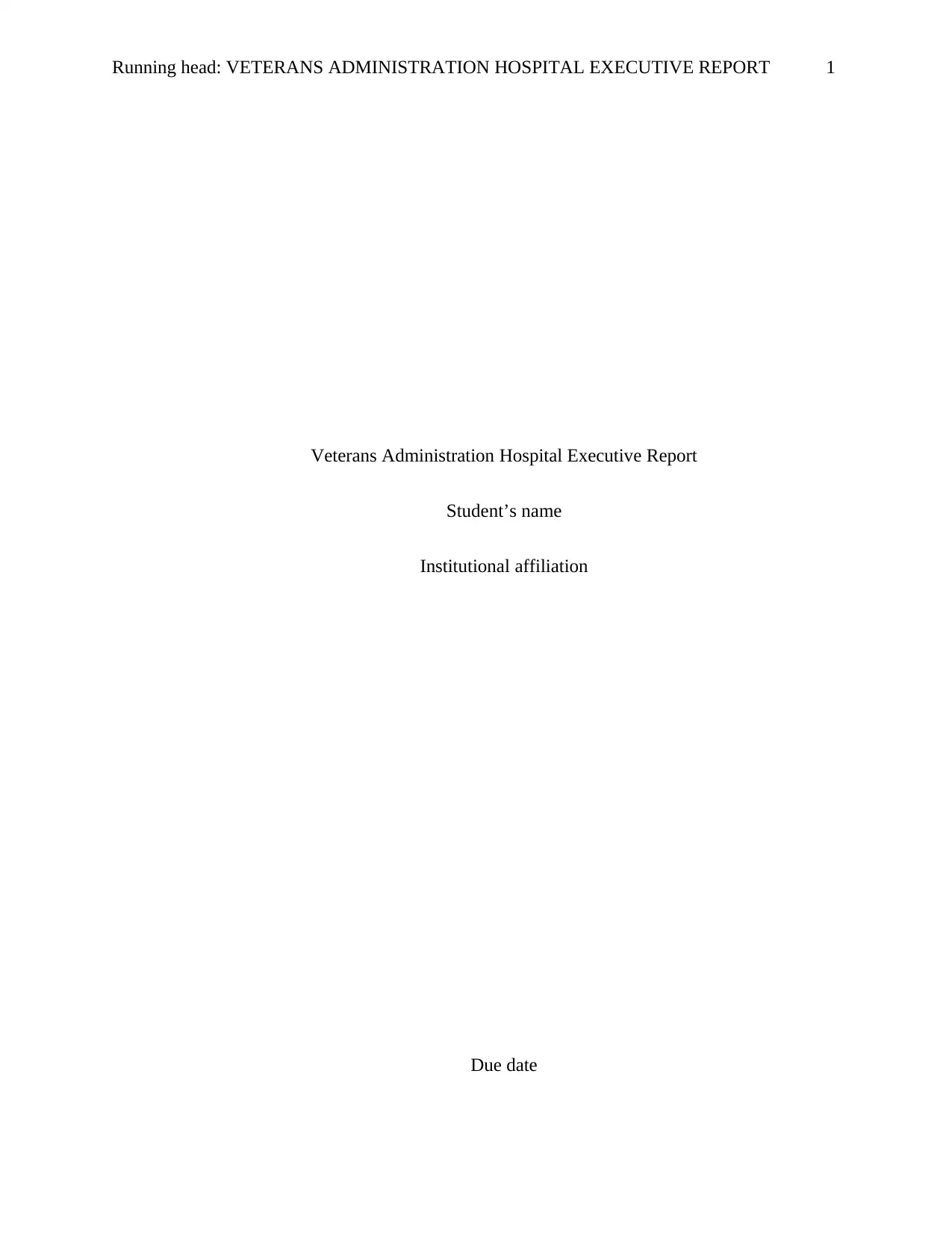
Running head: VETERANS ADMINISTRATION HOSPITAL EXECUTIVE REPORT 1
Veterans Administration Hospital Executive Report
Student’s name
Institutional affiliation
Due date
Veterans Administration Hospital Executive Report
Student’s name
Institutional affiliation
Due date
Paraphrase This Document
Need a fresh take? Get an instant paraphrase of this document with our AI Paraphraser
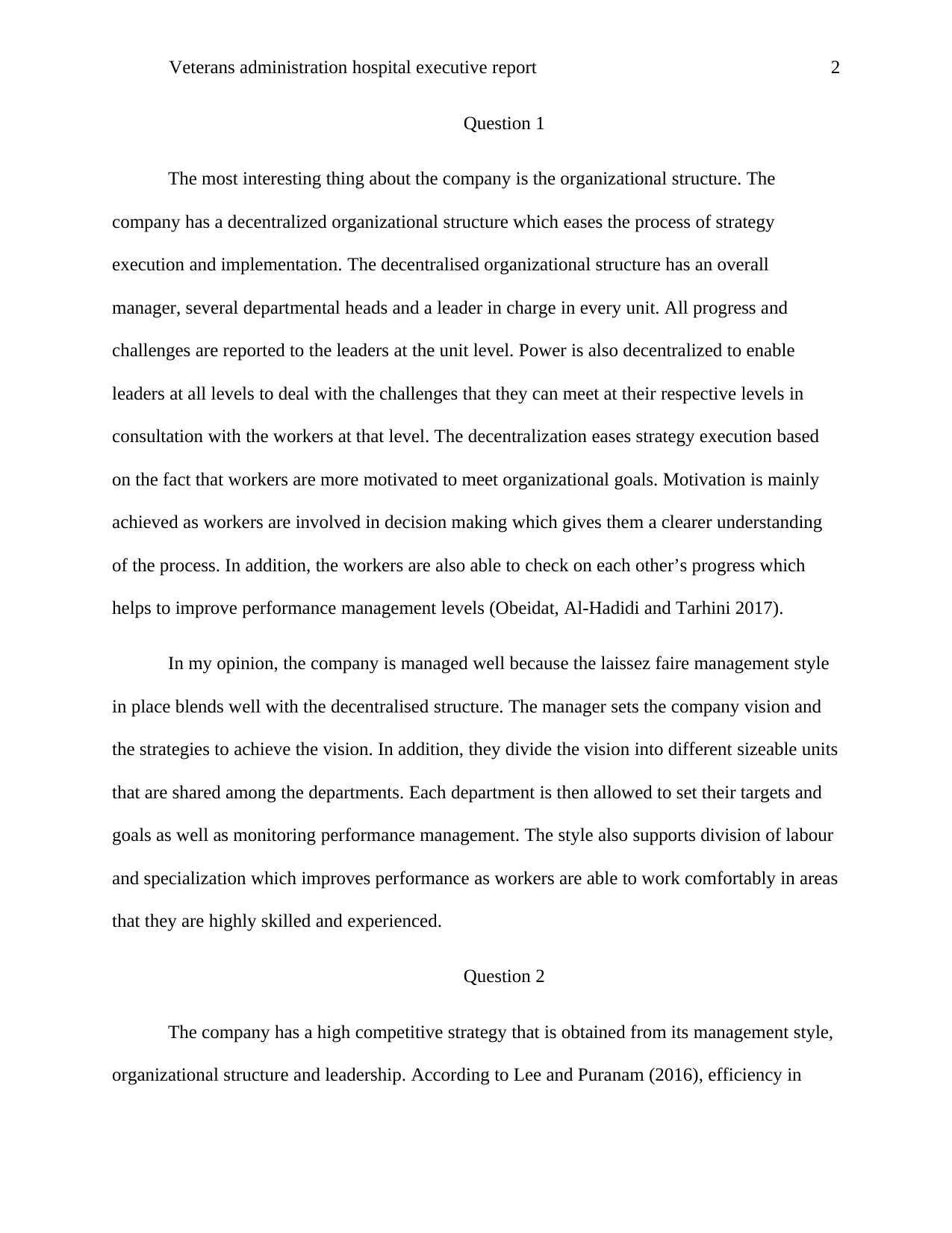
Veterans administration hospital executive report 2
Question 1
The most interesting thing about the company is the organizational structure. The
company has a decentralized organizational structure which eases the process of strategy
execution and implementation. The decentralised organizational structure has an overall
manager, several departmental heads and a leader in charge in every unit. All progress and
challenges are reported to the leaders at the unit level. Power is also decentralized to enable
leaders at all levels to deal with the challenges that they can meet at their respective levels in
consultation with the workers at that level. The decentralization eases strategy execution based
on the fact that workers are more motivated to meet organizational goals. Motivation is mainly
achieved as workers are involved in decision making which gives them a clearer understanding
of the process. In addition, the workers are also able to check on each other’s progress which
helps to improve performance management levels (Obeidat, Al-Hadidi and Tarhini 2017).
In my opinion, the company is managed well because the laissez faire management style
in place blends well with the decentralised structure. The manager sets the company vision and
the strategies to achieve the vision. In addition, they divide the vision into different sizeable units
that are shared among the departments. Each department is then allowed to set their targets and
goals as well as monitoring performance management. The style also supports division of labour
and specialization which improves performance as workers are able to work comfortably in areas
that they are highly skilled and experienced.
Question 2
The company has a high competitive strategy that is obtained from its management style,
organizational structure and leadership. According to Lee and Puranam (2016), efficiency in
Question 1
The most interesting thing about the company is the organizational structure. The
company has a decentralized organizational structure which eases the process of strategy
execution and implementation. The decentralised organizational structure has an overall
manager, several departmental heads and a leader in charge in every unit. All progress and
challenges are reported to the leaders at the unit level. Power is also decentralized to enable
leaders at all levels to deal with the challenges that they can meet at their respective levels in
consultation with the workers at that level. The decentralization eases strategy execution based
on the fact that workers are more motivated to meet organizational goals. Motivation is mainly
achieved as workers are involved in decision making which gives them a clearer understanding
of the process. In addition, the workers are also able to check on each other’s progress which
helps to improve performance management levels (Obeidat, Al-Hadidi and Tarhini 2017).
In my opinion, the company is managed well because the laissez faire management style
in place blends well with the decentralised structure. The manager sets the company vision and
the strategies to achieve the vision. In addition, they divide the vision into different sizeable units
that are shared among the departments. Each department is then allowed to set their targets and
goals as well as monitoring performance management. The style also supports division of labour
and specialization which improves performance as workers are able to work comfortably in areas
that they are highly skilled and experienced.
Question 2
The company has a high competitive strategy that is obtained from its management style,
organizational structure and leadership. According to Lee and Puranam (2016), efficiency in
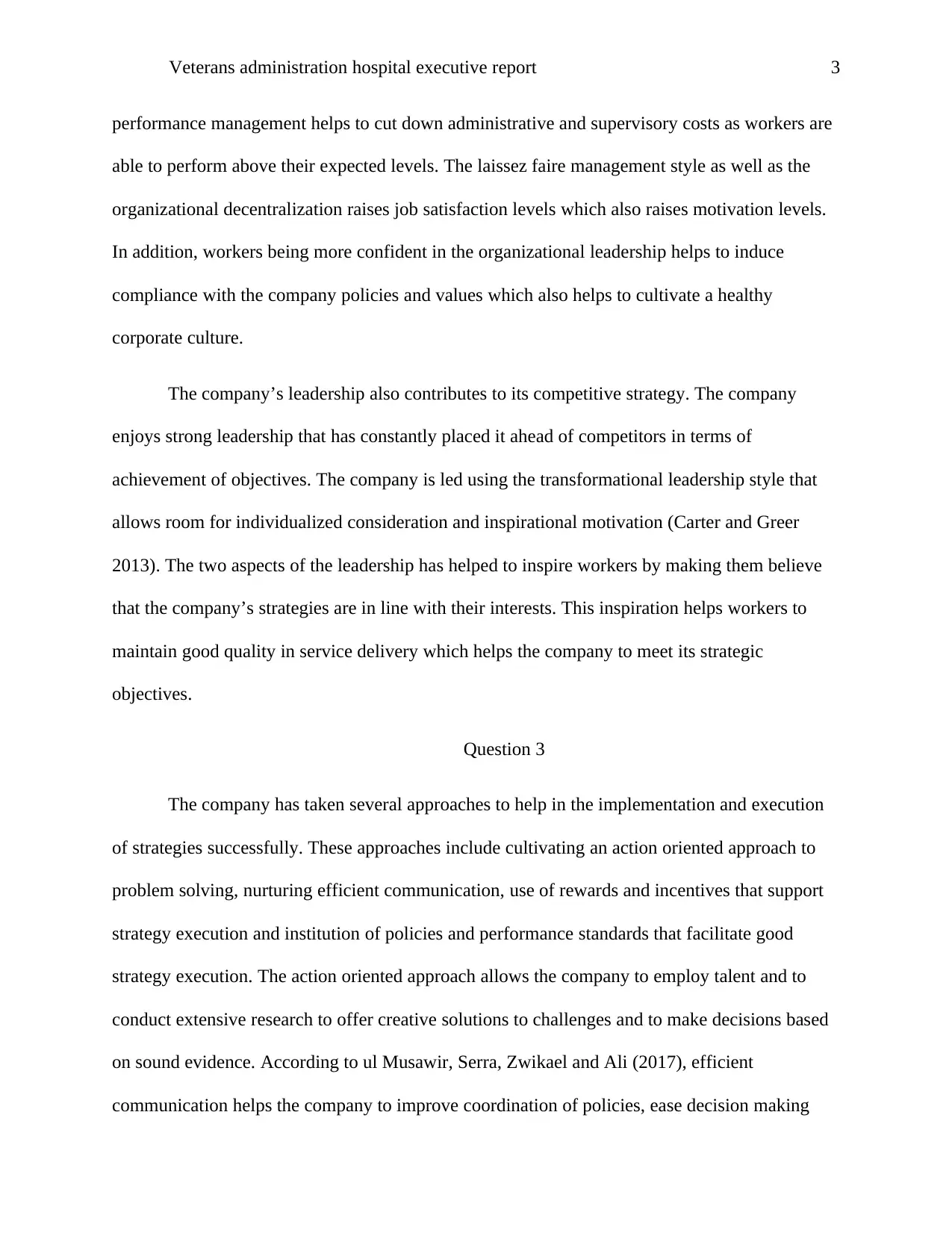
Veterans administration hospital executive report 3
performance management helps to cut down administrative and supervisory costs as workers are
able to perform above their expected levels. The laissez faire management style as well as the
organizational decentralization raises job satisfaction levels which also raises motivation levels.
In addition, workers being more confident in the organizational leadership helps to induce
compliance with the company policies and values which also helps to cultivate a healthy
corporate culture.
The company’s leadership also contributes to its competitive strategy. The company
enjoys strong leadership that has constantly placed it ahead of competitors in terms of
achievement of objectives. The company is led using the transformational leadership style that
allows room for individualized consideration and inspirational motivation (Carter and Greer
2013). The two aspects of the leadership has helped to inspire workers by making them believe
that the company’s strategies are in line with their interests. This inspiration helps workers to
maintain good quality in service delivery which helps the company to meet its strategic
objectives.
Question 3
The company has taken several approaches to help in the implementation and execution
of strategies successfully. These approaches include cultivating an action oriented approach to
problem solving, nurturing efficient communication, use of rewards and incentives that support
strategy execution and institution of policies and performance standards that facilitate good
strategy execution. The action oriented approach allows the company to employ talent and to
conduct extensive research to offer creative solutions to challenges and to make decisions based
on sound evidence. According to ul Musawir, Serra, Zwikael and Ali (2017), efficient
communication helps the company to improve coordination of policies, ease decision making
performance management helps to cut down administrative and supervisory costs as workers are
able to perform above their expected levels. The laissez faire management style as well as the
organizational decentralization raises job satisfaction levels which also raises motivation levels.
In addition, workers being more confident in the organizational leadership helps to induce
compliance with the company policies and values which also helps to cultivate a healthy
corporate culture.
The company’s leadership also contributes to its competitive strategy. The company
enjoys strong leadership that has constantly placed it ahead of competitors in terms of
achievement of objectives. The company is led using the transformational leadership style that
allows room for individualized consideration and inspirational motivation (Carter and Greer
2013). The two aspects of the leadership has helped to inspire workers by making them believe
that the company’s strategies are in line with their interests. This inspiration helps workers to
maintain good quality in service delivery which helps the company to meet its strategic
objectives.
Question 3
The company has taken several approaches to help in the implementation and execution
of strategies successfully. These approaches include cultivating an action oriented approach to
problem solving, nurturing efficient communication, use of rewards and incentives that support
strategy execution and institution of policies and performance standards that facilitate good
strategy execution. The action oriented approach allows the company to employ talent and to
conduct extensive research to offer creative solutions to challenges and to make decisions based
on sound evidence. According to ul Musawir, Serra, Zwikael and Ali (2017), efficient
communication helps the company to improve coordination of policies, ease decision making
⊘ This is a preview!⊘
Do you want full access?
Subscribe today to unlock all pages.

Trusted by 1+ million students worldwide
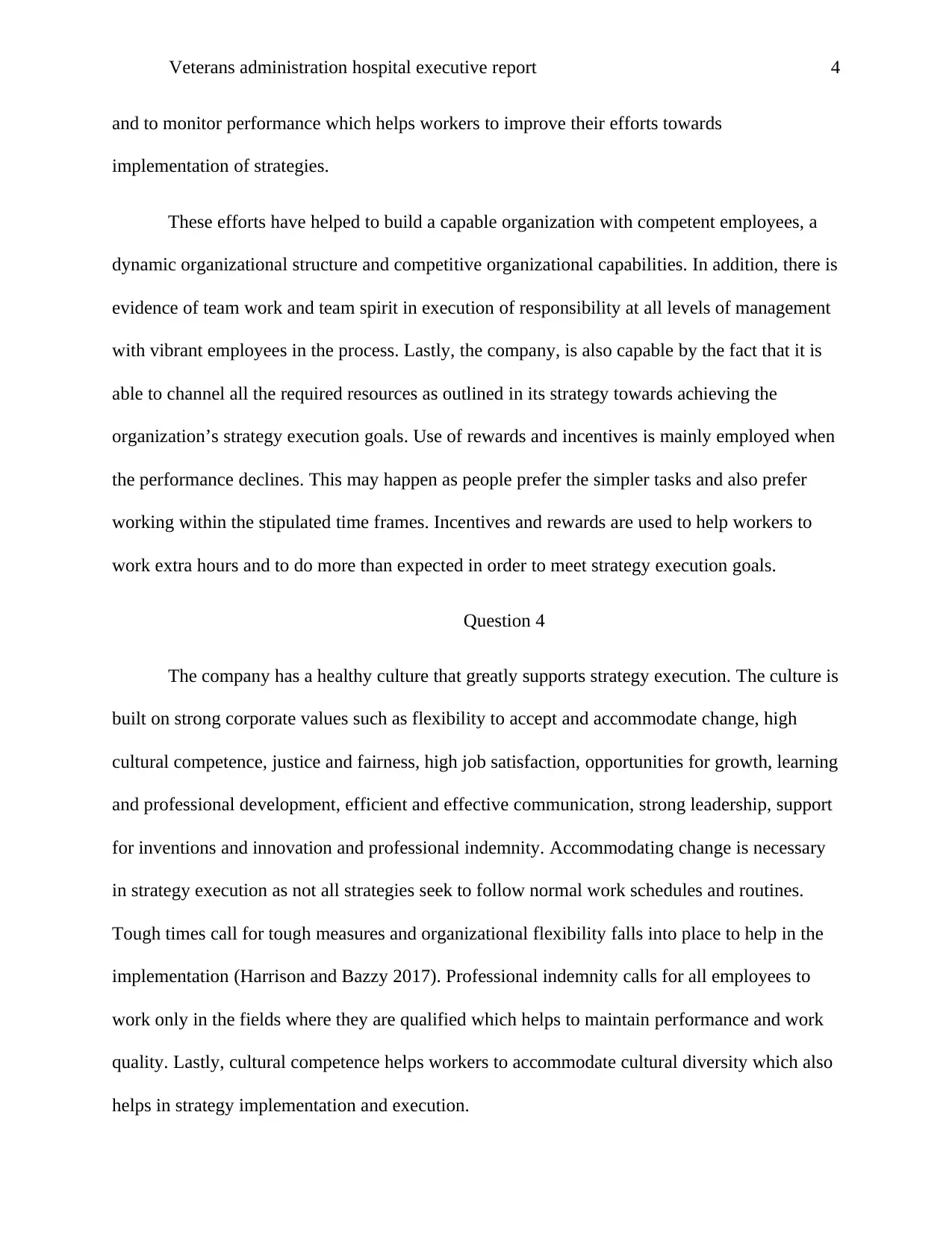
Veterans administration hospital executive report 4
and to monitor performance which helps workers to improve their efforts towards
implementation of strategies.
These efforts have helped to build a capable organization with competent employees, a
dynamic organizational structure and competitive organizational capabilities. In addition, there is
evidence of team work and team spirit in execution of responsibility at all levels of management
with vibrant employees in the process. Lastly, the company, is also capable by the fact that it is
able to channel all the required resources as outlined in its strategy towards achieving the
organization’s strategy execution goals. Use of rewards and incentives is mainly employed when
the performance declines. This may happen as people prefer the simpler tasks and also prefer
working within the stipulated time frames. Incentives and rewards are used to help workers to
work extra hours and to do more than expected in order to meet strategy execution goals.
Question 4
The company has a healthy culture that greatly supports strategy execution. The culture is
built on strong corporate values such as flexibility to accept and accommodate change, high
cultural competence, justice and fairness, high job satisfaction, opportunities for growth, learning
and professional development, efficient and effective communication, strong leadership, support
for inventions and innovation and professional indemnity. Accommodating change is necessary
in strategy execution as not all strategies seek to follow normal work schedules and routines.
Tough times call for tough measures and organizational flexibility falls into place to help in the
implementation (Harrison and Bazzy 2017). Professional indemnity calls for all employees to
work only in the fields where they are qualified which helps to maintain performance and work
quality. Lastly, cultural competence helps workers to accommodate cultural diversity which also
helps in strategy implementation and execution.
and to monitor performance which helps workers to improve their efforts towards
implementation of strategies.
These efforts have helped to build a capable organization with competent employees, a
dynamic organizational structure and competitive organizational capabilities. In addition, there is
evidence of team work and team spirit in execution of responsibility at all levels of management
with vibrant employees in the process. Lastly, the company, is also capable by the fact that it is
able to channel all the required resources as outlined in its strategy towards achieving the
organization’s strategy execution goals. Use of rewards and incentives is mainly employed when
the performance declines. This may happen as people prefer the simpler tasks and also prefer
working within the stipulated time frames. Incentives and rewards are used to help workers to
work extra hours and to do more than expected in order to meet strategy execution goals.
Question 4
The company has a healthy culture that greatly supports strategy execution. The culture is
built on strong corporate values such as flexibility to accept and accommodate change, high
cultural competence, justice and fairness, high job satisfaction, opportunities for growth, learning
and professional development, efficient and effective communication, strong leadership, support
for inventions and innovation and professional indemnity. Accommodating change is necessary
in strategy execution as not all strategies seek to follow normal work schedules and routines.
Tough times call for tough measures and organizational flexibility falls into place to help in the
implementation (Harrison and Bazzy 2017). Professional indemnity calls for all employees to
work only in the fields where they are qualified which helps to maintain performance and work
quality. Lastly, cultural competence helps workers to accommodate cultural diversity which also
helps in strategy implementation and execution.
Paraphrase This Document
Need a fresh take? Get an instant paraphrase of this document with our AI Paraphraser
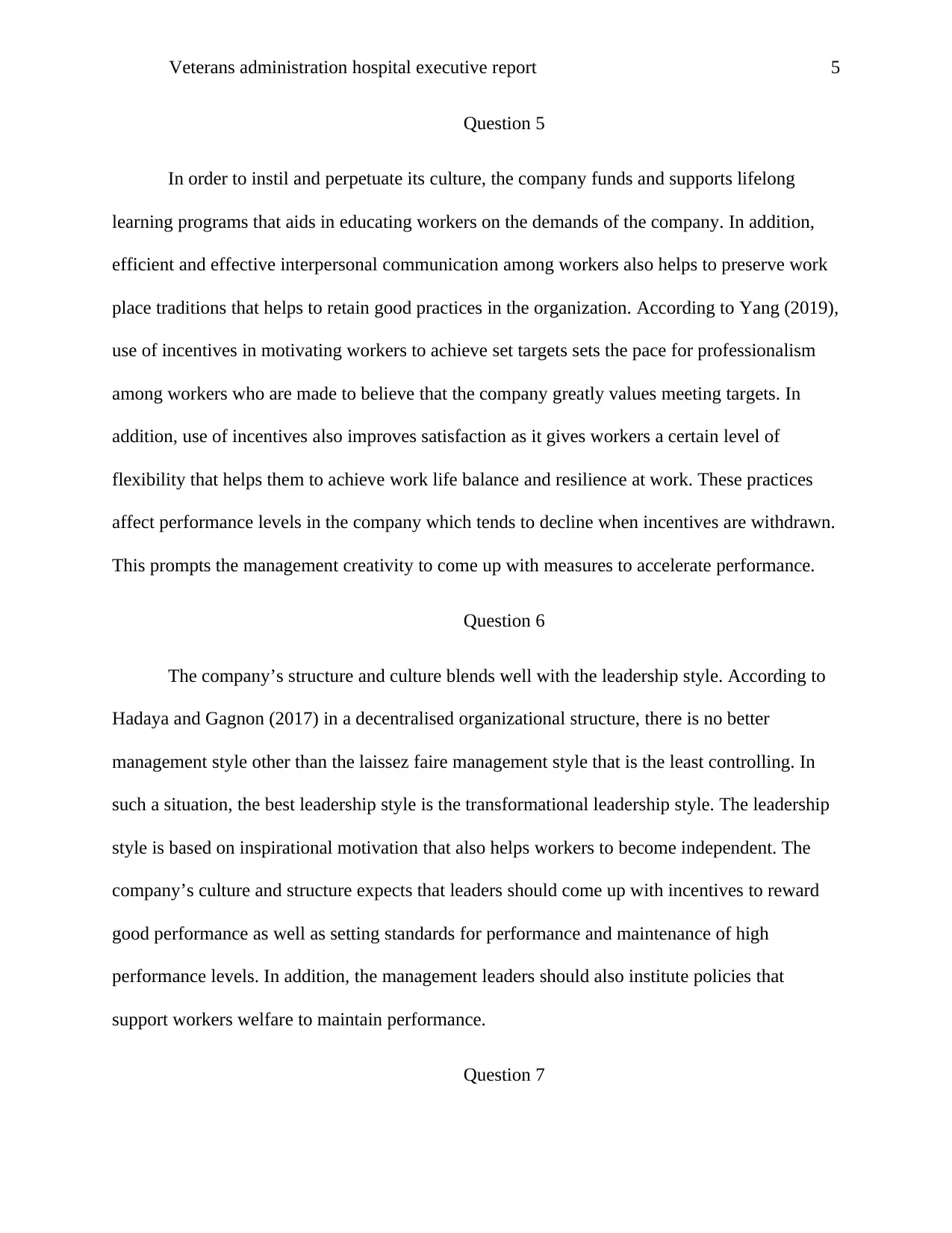
Veterans administration hospital executive report 5
Question 5
In order to instil and perpetuate its culture, the company funds and supports lifelong
learning programs that aids in educating workers on the demands of the company. In addition,
efficient and effective interpersonal communication among workers also helps to preserve work
place traditions that helps to retain good practices in the organization. According to Yang (2019),
use of incentives in motivating workers to achieve set targets sets the pace for professionalism
among workers who are made to believe that the company greatly values meeting targets. In
addition, use of incentives also improves satisfaction as it gives workers a certain level of
flexibility that helps them to achieve work life balance and resilience at work. These practices
affect performance levels in the company which tends to decline when incentives are withdrawn.
This prompts the management creativity to come up with measures to accelerate performance.
Question 6
The company’s structure and culture blends well with the leadership style. According to
Hadaya and Gagnon (2017) in a decentralised organizational structure, there is no better
management style other than the laissez faire management style that is the least controlling. In
such a situation, the best leadership style is the transformational leadership style. The leadership
style is based on inspirational motivation that also helps workers to become independent. The
company’s culture and structure expects that leaders should come up with incentives to reward
good performance as well as setting standards for performance and maintenance of high
performance levels. In addition, the management leaders should also institute policies that
support workers welfare to maintain performance.
Question 7
Question 5
In order to instil and perpetuate its culture, the company funds and supports lifelong
learning programs that aids in educating workers on the demands of the company. In addition,
efficient and effective interpersonal communication among workers also helps to preserve work
place traditions that helps to retain good practices in the organization. According to Yang (2019),
use of incentives in motivating workers to achieve set targets sets the pace for professionalism
among workers who are made to believe that the company greatly values meeting targets. In
addition, use of incentives also improves satisfaction as it gives workers a certain level of
flexibility that helps them to achieve work life balance and resilience at work. These practices
affect performance levels in the company which tends to decline when incentives are withdrawn.
This prompts the management creativity to come up with measures to accelerate performance.
Question 6
The company’s structure and culture blends well with the leadership style. According to
Hadaya and Gagnon (2017) in a decentralised organizational structure, there is no better
management style other than the laissez faire management style that is the least controlling. In
such a situation, the best leadership style is the transformational leadership style. The leadership
style is based on inspirational motivation that also helps workers to become independent. The
company’s culture and structure expects that leaders should come up with incentives to reward
good performance as well as setting standards for performance and maintenance of high
performance levels. In addition, the management leaders should also institute policies that
support workers welfare to maintain performance.
Question 7
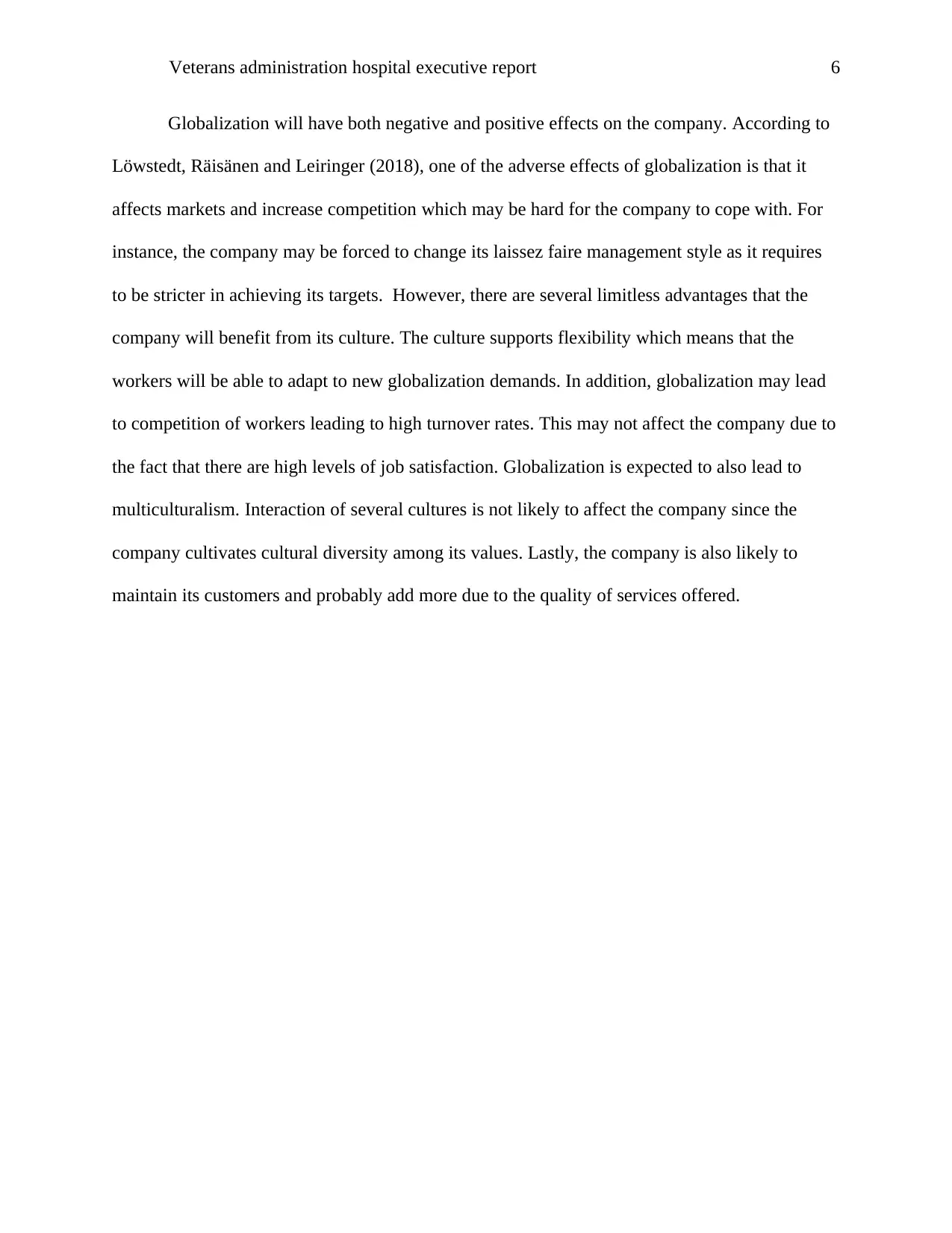
Veterans administration hospital executive report 6
Globalization will have both negative and positive effects on the company. According to
Löwstedt, Räisänen and Leiringer (2018), one of the adverse effects of globalization is that it
affects markets and increase competition which may be hard for the company to cope with. For
instance, the company may be forced to change its laissez faire management style as it requires
to be stricter in achieving its targets. However, there are several limitless advantages that the
company will benefit from its culture. The culture supports flexibility which means that the
workers will be able to adapt to new globalization demands. In addition, globalization may lead
to competition of workers leading to high turnover rates. This may not affect the company due to
the fact that there are high levels of job satisfaction. Globalization is expected to also lead to
multiculturalism. Interaction of several cultures is not likely to affect the company since the
company cultivates cultural diversity among its values. Lastly, the company is also likely to
maintain its customers and probably add more due to the quality of services offered.
Globalization will have both negative and positive effects on the company. According to
Löwstedt, Räisänen and Leiringer (2018), one of the adverse effects of globalization is that it
affects markets and increase competition which may be hard for the company to cope with. For
instance, the company may be forced to change its laissez faire management style as it requires
to be stricter in achieving its targets. However, there are several limitless advantages that the
company will benefit from its culture. The culture supports flexibility which means that the
workers will be able to adapt to new globalization demands. In addition, globalization may lead
to competition of workers leading to high turnover rates. This may not affect the company due to
the fact that there are high levels of job satisfaction. Globalization is expected to also lead to
multiculturalism. Interaction of several cultures is not likely to affect the company since the
company cultivates cultural diversity among its values. Lastly, the company is also likely to
maintain its customers and probably add more due to the quality of services offered.
⊘ This is a preview!⊘
Do you want full access?
Subscribe today to unlock all pages.

Trusted by 1+ million students worldwide
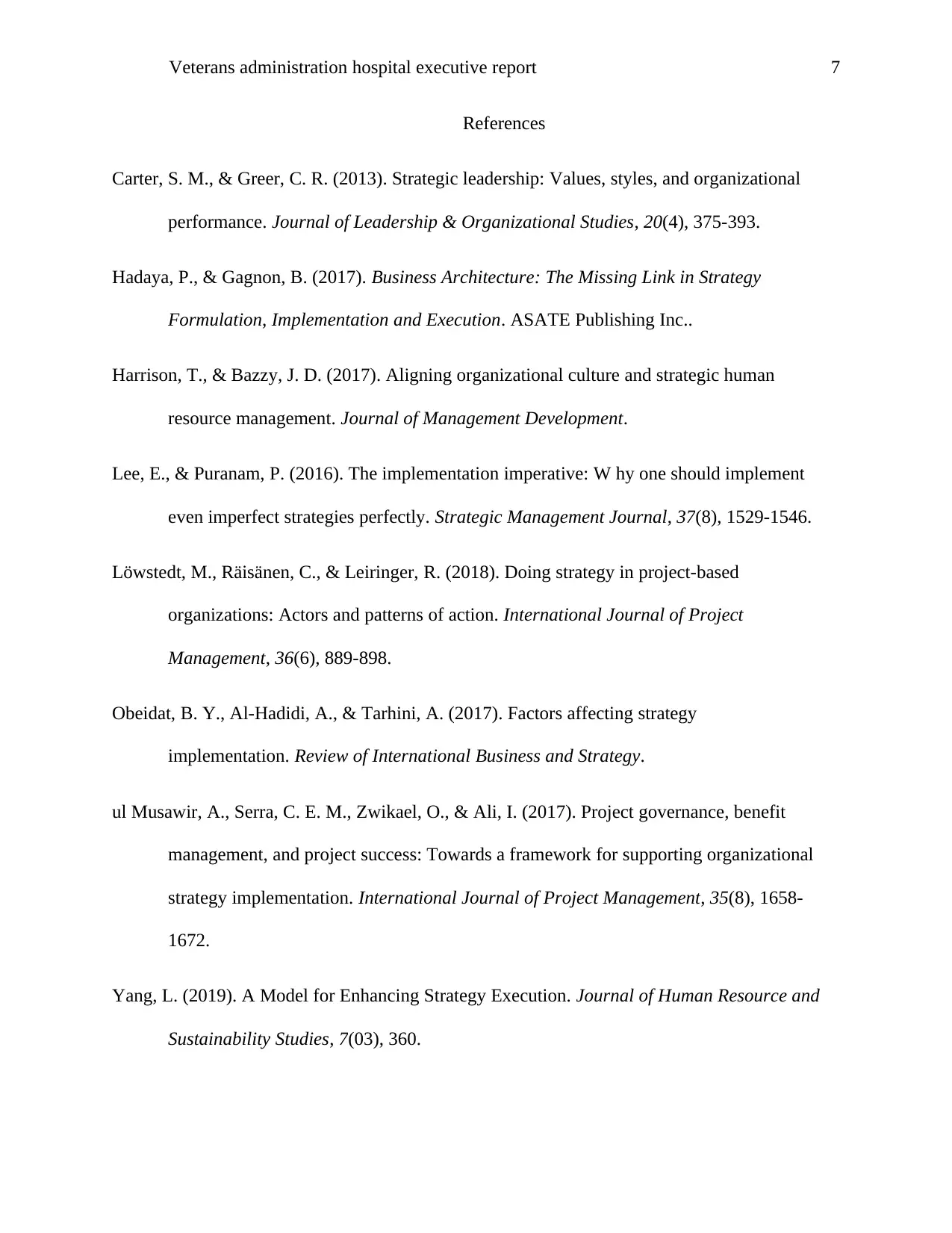
Veterans administration hospital executive report 7
References
Carter, S. M., & Greer, C. R. (2013). Strategic leadership: Values, styles, and organizational
performance. Journal of Leadership & Organizational Studies, 20(4), 375-393.
Hadaya, P., & Gagnon, B. (2017). Business Architecture: The Missing Link in Strategy
Formulation, Implementation and Execution. ASATE Publishing Inc..
Harrison, T., & Bazzy, J. D. (2017). Aligning organizational culture and strategic human
resource management. Journal of Management Development.
Lee, E., & Puranam, P. (2016). The implementation imperative: W hy one should implement
even imperfect strategies perfectly. Strategic Management Journal, 37(8), 1529-1546.
Löwstedt, M., Räisänen, C., & Leiringer, R. (2018). Doing strategy in project-based
organizations: Actors and patterns of action. International Journal of Project
Management, 36(6), 889-898.
Obeidat, B. Y., Al-Hadidi, A., & Tarhini, A. (2017). Factors affecting strategy
implementation. Review of International Business and Strategy.
ul Musawir, A., Serra, C. E. M., Zwikael, O., & Ali, I. (2017). Project governance, benefit
management, and project success: Towards a framework for supporting organizational
strategy implementation. International Journal of Project Management, 35(8), 1658-
1672.
Yang, L. (2019). A Model for Enhancing Strategy Execution. Journal of Human Resource and
Sustainability Studies, 7(03), 360.
References
Carter, S. M., & Greer, C. R. (2013). Strategic leadership: Values, styles, and organizational
performance. Journal of Leadership & Organizational Studies, 20(4), 375-393.
Hadaya, P., & Gagnon, B. (2017). Business Architecture: The Missing Link in Strategy
Formulation, Implementation and Execution. ASATE Publishing Inc..
Harrison, T., & Bazzy, J. D. (2017). Aligning organizational culture and strategic human
resource management. Journal of Management Development.
Lee, E., & Puranam, P. (2016). The implementation imperative: W hy one should implement
even imperfect strategies perfectly. Strategic Management Journal, 37(8), 1529-1546.
Löwstedt, M., Räisänen, C., & Leiringer, R. (2018). Doing strategy in project-based
organizations: Actors and patterns of action. International Journal of Project
Management, 36(6), 889-898.
Obeidat, B. Y., Al-Hadidi, A., & Tarhini, A. (2017). Factors affecting strategy
implementation. Review of International Business and Strategy.
ul Musawir, A., Serra, C. E. M., Zwikael, O., & Ali, I. (2017). Project governance, benefit
management, and project success: Towards a framework for supporting organizational
strategy implementation. International Journal of Project Management, 35(8), 1658-
1672.
Yang, L. (2019). A Model for Enhancing Strategy Execution. Journal of Human Resource and
Sustainability Studies, 7(03), 360.
1 out of 7
Related Documents
Your All-in-One AI-Powered Toolkit for Academic Success.
+13062052269
info@desklib.com
Available 24*7 on WhatsApp / Email
![[object Object]](/_next/static/media/star-bottom.7253800d.svg)
Unlock your academic potential
Copyright © 2020–2025 A2Z Services. All Rights Reserved. Developed and managed by ZUCOL.




